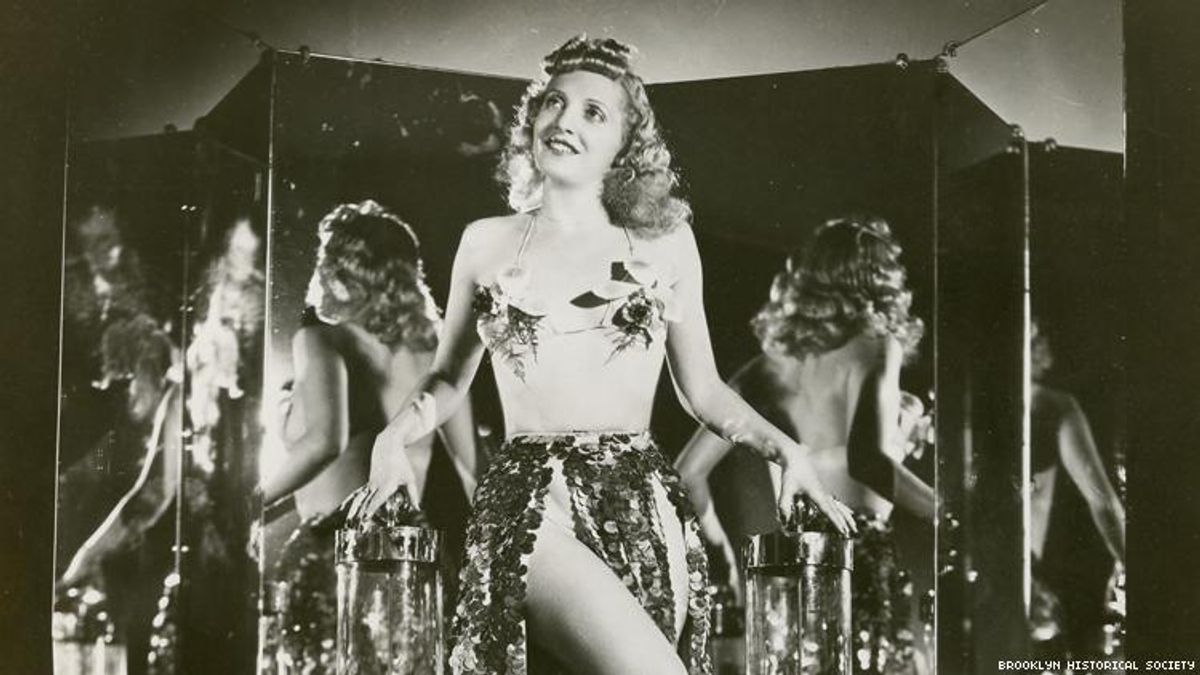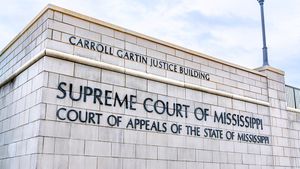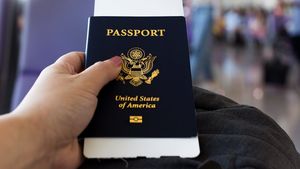All Rights reserved
By continuing to use our site, you agree to our Private Policy and Terms of Use.
If you want to think about it this way, Hugh Ryan is something of a gay Indiana Jones. As a historian, he has spent the last five years running around the nooks and crannies of Brooklyn unearthing its lost or erased queer histories. In my own mind, I imagine him dusting off ancient books with tattered covers, ducking into dark, drippy caves holding a lantern, and perhaps grabbing his hat from underneath a slowly closing trap door to narrowly escape a wild pack of Chelsea gays.
These five years of research-- which looked more like many hours spent in the halls of New York public libraries, sifting through legal records and newspapers, making lots of phone calls, and cold emails -- culminated in the exquisite, strange, and beautiful book that is When Brooklyn Was Queer, published March 5. Another project of Ryan's you might know is The Pop-Up Museum of Queer History, a travelling archival project that places installations all across the country highlighting LGBTQ+ stories. (And fun fact, when I was a wee undergrad in 2012, I actually worked with my queer resource center in Bloomington, Indiana to fund bringing the installation to my middle-of-nowhere corn town.)
Starting from the 1850s, all the way to the Stonewall riots, Ryan's historic (and underappreciated) masterpiece is a treasure trove and gift to queer communities and all the subcultures inside of them. From Whitman, to Hart Crane, to gay Nazi spy sex scandals, this book tells all the stories you didn't know about the borough's rich queer history. Here, he shares an excerpt with us about Robert Moses, who tried his best to destroy Coney Island by taking over the real estate scene there. But there was one woman, a queer stripper (and licensed U-Haul driver) by the name of Madame Tirza, who just wasn't going to let that happen. -- Fran Tirado, Deputy Editor of Out
Trending stories
When Brooklyn Was Queerby Hugh Ryan is out March 5.
You had to have three pieces of female attire. Now, let's put it this way. At the time I was young, I had nothing on top so what the hell was I going to put in a brassiere? I'm not exactly the type for lace panties. And if I'm wearing pants, I sure as hell didn't need a pretty coat. So there goes your three pieces of female attire.
This "three-piece rule" is often cited by people writing about postwar New York, and by the folks who lived at that time, such as Brown. But no such law appears on the books. It seems likely that police policy specified wearing three pieces of clothing of the "appropriate gender" to avoid a cross-dressing arrest, since so many people reference it, but all the arrests relied on the same set of laws that had been used to police gender identity and sexuality for decades: the old masquerade, public nuisance, and disorderly conduct laws. Arrests were simply more frequent, in part because more women were wearing pants in general, giving genderqueer women slightly more room to express themselves on the streets (and thus making them that much more visible to the police). Although the laws hadn't changed, enforcement had.
Once, when Brown's partner convinced her to switch parts -- to dress "appropriately" for their genders -- Brown was arrested again, and this time thrown into the men's jail overnight, where she recalled the other prisoners screaming, "Bad enough you got us in this jail, you have to put this damn fag in here with us." Too masculine for dresses and not allowed to wear suits, Brown seemed to have no way to win.
Working as a drag king brought Brown down to Coney Island, where she would meet the love of her life, a burlesque dancer named Terry. When Terry noticed Brown in the front row of Terry's show at Madam Tirza's Wine Bath, she sent a note inviting Brown to her dressing room afterward. "This chick has got to be straight," thought Brown. But the two were together for the next twenty-eight years.
Madam Tirza herself was a fascinating woman. According to another of her dancers, Mary Hood, Tirza was "a he-she, she-he . . . she'll either fall in love with a man or a woman." If Tirza was out late the night before with a girl, Hood recalled, she or another of the backup girls would be Madam Tirza for a day, shimmying beneath a many-headed fountain of red-dyed water, surrounded by a phalanx of mirrors that turned one dancing girl into five.
Tirza had invented her wine-bath routine shortly before the war. While contemplating the beautiful Bethesda Fountain in Central Park one day, she realized how fabulous her act would look set inside it. So she hired an architect, who developed a prototype that weighed so much it was impossible to move. Frustrated, Tirza took a sledgehammer and refashioned it herself, just in time to get sponsored by a Chicago wine company and present her act at the 1940 World's Fair in New York (the same one that featured Gypsy Rose Lee). After that, Tirza was on the road for years, dragging along her twelve-hundred-pound wine fountain. The tank required a lot of setup and maintenance, and the ranks of skilled workers had been badly depleted by the war, so Tirza became a member in good standing of the plumbers union, as well as a licensed trucker. She summered at Coney Island, where her act soon became a well-known draw. Later, Tirza would recall this time as the "best run" she ever had.
After the war, however, Coney Island quickly began to hit the skids. In 1945, for the first time ever, its summer crowds were bested by Rockaway Beach, which had twice the number of visitors. In June 1946, Tirza's Wine Bath--along with two other Coney Island burlesques--was temporarily shuttered by the city license commissioner, Ben Fielding. Tirza's mother, who helped with the show, shadily pointed out that even under the restrictive La Guardia administration (which had closed all the official burlesque houses in the city), Tirza had been allowed to operate. "I think Mr. Fielding is a very fair and square gentleman," she told a reporter, "even if we were allowed to continue under La Guardia's administration without a bit of trouble. Maybe we went a little further than we meant this time, thinking it was a Democratic administration and a little gayer somehow. But we guessed wrong." (Gay was already being used to refer to homosexual men by this time, and it still retained echoes of its earlier slang meaning, referring to female sex workers, but it's not clear in what sense Tirza's mother meant it here.)
By August of that year, the women's columnist at the Star newspaper noted that the city wasn't just going after the bump-and-grind joints. All of Coney Island seemed set in its sights. "Every day brings a new wave of censorship," she wrote. "Coney Island bath houses by the dozen have been closed in the clean up." The barkers, whose ballyhoos brought the rubes in to see the shows, were now forced to submit their scripts to the License Commission for advance approval.
Coney Island restaurants would be hit with numerous sanitary citations. Even the visiting crowds were suddenly subjected to increased scrutiny. Over six thousand people were ticketed in the first half of 1946 for such crimes as "undressing on the beach," "ball-playing," and "peddling." This was nearly a 40 percent increase over the year before.
This wasn't just an attack on Coney Island, it was a growing war on poverty -- or rather, a war on the poor and the places they congregated. Soon, Commissioner Fielding promised, "each of the city's 102 bathing establishments . . . will be the subject of unexpected visits by our department." Coney Island bathhouses most likely came under particular scrutiny because both poor people and homosexuals could be found in them. Coney Island was rapidly losing its reputation as a destination for all New Yorkers and being reimagined, in the words of one city magistrate, as a "Devil's play pen," where "one million poor people swarm onto the beach."
By 1949, the signs were serious that Coney Island was in trouble. The long standing Mardi Gras festival was canceled that year, "a victim of economic pressure." Luna Park, the famed amusement park that burned down in 1945, had been purchased by real estate speculator Fred Trump (father of President Donald Trump). Although Fred Trump planned in 1950 to turn it into a drive-in movie complex, eventually he built a parking lot instead.
In 1952, the License Commission would again shut down Madam Tirza, and in 1953, put off by the dwindling crowds, the increase in petty crime, and the constant government harassment, none of the bump-and-grind shows even bothered to apply for a license. As Tirza recalled, "Coney Island had deteriorated so badly I was afraid to open. Around this time, she married a Coney Island local named Joe Boston, and the two spent the next thirty years together on the road.
(As for Rusty Brown and Terry, they moved to California, where they lived together until Terry died, and Rusty remained active in queer life up through the late 1990s.)
In the face of this increased regulation, Brooklyn residents yet again showed more blase attitude toward sex at Coney Island than their Manhattan overlords. Under the headline "Poor Man Must Be Protected from Girls in Bath," one local wrote to The Brooklyn Daily Eagle to drily observe:
The poor man who cannot enter a New York night club with a well-stuffed wallet and a collar and tie--the same man, who simply can't resist the barkers appeal to 'hurry,' 'hurry,' 'hurry,' to see Tirza, should and must feel a deep sense of appreciation to our Acting Commissioner of Licenses for protecting his morals.
Newspaper articles tried to put a good face on the closings, insisting that "some merchants hereabouts say it's better for business," but Coney Island was inexorably dwindling away.64 Boosterish headlines blared that Coney wasn't folding, but their very protests seemed to certify the exact thing they were trying to deny. "The Nickel Empire" was once a compliment to the pinnacle of New York attractions, but now it was a snide reference to how cheap and tawdry Coney had become.
What had happened? The answer, in two words: Robert Moses.
No history of twentieth-century New York City and its marginalized communities can avoid talking about Moses, the incredibly powerful city administration figure who almost single-handedly redesigned New York as a city for cars and the people who could afford them. At one point in his career, he held twelve simultaneous government positions (all appointed, none elected), including commissioner of the NYC Parks Department, chairman of the Triborough Bridge Authority, chairman of the Long Island State Parks Commission, chairman of the Mayor's Committee on Slum Clearance, and others. A short list of New York City projects that are wholly or mostly the work of Moses include the Throgs Neck, Whitestone, Henry Hudson, and Verrazzano Bridges; the Brooklyn-Queens Expressway, the Staten Island Expressway, and the Meadowbrook Parkway; the Brooklyn-Battery Tunnel; Idlewild Airport (now JFK); Lincoln Center; Shea Stadium; and much of the city's public housing.
Robert Moses obviously disliked Coney Island. In 1949, he said in a public meeting that he "wouldn't want to sink Surf Avenue on Coney Island, but just get rid of about a third of it." He imagined a clean, empty expanse of beach -- much like the ones he had created on Long Island--where there were no "gadgets or catch penny devices." When he looked at the history of Coney, he said, "The trend is downward."
In part, that trend can be traced back to Moses himself, who had been surreptitiously eating away at Coney Island since the mid-1930s. In 1935, for example, Moses wanted twenty-five acres of land on Coney Island to build a park. The land was in the hands of the Board of Education, which planned to build a "badly needed school" for the local community. When Mayor La Guardia had the temerity to suggest a mixed-use site, with a park on one side and a school on the other, Moses savaged him in public, causing the mayor to back down. Moses got his park, and Coney Island residents were forced to make do. In 1938, Moses--again via the Parks Department--took control of the Municipal Bathhouse at Coney Island. The year before, it had seen some 150,000 visitors, of who approximately 7,500 were "charity admissions," who paid no fee. Seeing the great need that the bathhouse was meeting, Moses turned it into a storage complex for Parks Department equipment. That same year, Moses succeeded in having jurisdiction over the boardwalk and beaches of Coney Island removed from local borough-president control and placed under his aegis. Although World War II slowed him down, from this point on, it was only a matter of time before Moses remade Coney Island to his wishes.
As Madam Tirza's history shows, many of the attractions at Coney Island were temporary. Some returned every year, others were there for a while and then moved on. Like the Brooklyn brothels, they depended on some turnover to keep functioning. Moses saw in this an opportunity. By 1949, he estimated that through his powers at the Parks Department, he had acquired about one-third of the land along the boardwalk in Coney Island. The owners of these properties had slipped into bankruptcy or simply skipped town when winter arrived, never paying the debts they had accumulated. By buying up the properties, Moses could keep the businesses empty, inexorably accelerating the decline of Coney Island, and thereby allowing the Parks Department to gobble up more and more land. By 1952 -- Madam Tirza's last year -- he was ready to deliver his coup de grace: a giant redevelopment that would turn Coney Island from a "noisy amusement area to a beautiful, residential center with its buildings set in spacious, landscaped grounds."
Publicly, he claimed that the redevelopment would provide the city with renewed tax revenue, without ever discussing how the freeways and parkways he was building were creating a commuter class that left the city for the suburbs, taking their tax money with them. He ironically insisted that he was protecting Coney Island from "outsiders," who had abandoned the businesses he had purchased Coney Island residents weren't fooled, however, and they protested vigorously against the redevelopment. In April 1953, the Coney Island Chamber of Commerce unanimously rejected Moses's plan. In particular, the members were concerned about the rezoning of major parts of Coney Island from business to residential or retail. Both designations would effectively outlaw the games, music halls, dance pavilions, bathhouses, and other establishments that made Coney Island the unique destination it had been for decades. However, their concerns were ignored, and the redevelopment moved forward.
Moses was eager to redevelop Coney Island for a few reasons. It was the only beach that was easily accessible by public transit, and he wanted to push city residents out to his farther-flung, car-accessible beaches. Also the city's "poorest residents happened to live" here already, making it an ideal spot, in Moses's mind, for high-rise public housing projects, which could contain a maximum number of poor people at the farthest distance from the city's core--aka Manhattan. And from his experience on the Mayor's Committee on Slum Clearance, Moses knew that poor communities were less likely to be listened to if they protested his plans.
Coney Island had also accidentally got caught up in another of Moses's schemes. He loved bridges and hated tunnels, though the latter were cheaper to build and displaced fewer people. Instead of the Brooklyn-Battery Tunnel, he had wanted to build a bridge; when his plans were thwarted, he came up with a creative fuck-you to the city. In October 1941, he summarily began the destruction of the beloved New York Aquarium, which had been located in Battery Park, Manhattan, since 1896. He claimed--erroneously--that building the Brooklyn-Battery Tunnel would undermine its structural integrity. He proposed relocating the aquarium to Coney Island and pressured the mayor to spend $1 million on land for its new home.
Moses claimed it would cost just an additional $2 million to build the new aquarium, and that the money would come from the New York Zoological Society (which oversaw the Bronx Zoo). In the end, it cost $11 million, all paid by New York City taxes. As Moses's biographer Robert Caro wrote in The Power Broker: The high admission fees Moses set for it insured that many New Yorkers were going to be able to visit infrequently if at all. The poignance of this situation was accentuated by the location of the Aquarium at Coney Island, the lone bathing beach reachable by public transportation and therefore the one to which, because of Moses' class-separating policies, the city's poor were herded.
The old aquarium was free; despite claims from the city that the new aquarium would cost "considerably less than a dollar" to visit, the admission price was set at ninety cents.74 Since Moses started demolition of the old aquarium with no plans for a new one, New York City would spend sixteen years without an aquarium. Construction would take so long that for eleven of those years, Coney Island had twelve acres of desolate, unused land directly abutting the boardwalk.
When it finally opened, Moses called the aquarium "the symbol of a new era," one in which they were "shrinking the amusement section to proper limits and getting rid of its worst manifestations." In one last stab in the back to old Coney Island, Moses erected a quarter-of-a-million-dollar ramp from the subway station to the new aquarium, which was designed to "'funnel all' potential customers to and from the beach and waterside aquarium area and away from the amusement[s]."
What little of Coney Island Moses could not buy or bully into closing, he starved into submission. Moses's plan had direct effects on the businesses of Coney Island that provided queer women with work, but its ripples would disturb the cruising grounds that gay men had established on the beach and in the bathhouses at least as far back as the 1920s. By 1949, when the mysterious author Swasarnt Nerf published The Gay Girl's Guide (the first gay guide to New York ever written), it listed only two places in all of Brooklyn: the St. George Hotel in Brooklyn Heights, and the beach at Coney Island, where "some of the lowlier f****ts on occasion form a large party to take over a section." Thomas Painter, now long separated from the Committee for the Study of Sex Variants, was one of those f****ts, and he carefully tracked cruising culture at Coney in his letters to Alfred Kinsey throughout the 1940s and the beginning of the 1950s.
That Painter loved Coney Island is inarguable. When he first started going, men and women of all social classes and identities still crowded together on its beaches from Memorial Day to Labor Day, sometimes millions at a time. A group of Jewish matrons might sit under umbrellas just a few feet from a raucous collection of Italian-immigrant teenagers necking to Sammy Kaye on the radio singing "Careless Hands." Beachcombers made a living plucking dropped nickels and lost jewelry from the dunes. Young men impressed young women by doing acrobatics and weight lifting on the forgiving sand, and if they were lucky, they could retire to the cool shade beneath the boardwalk, where nameless, transient joints served soda, beer, and cheap beach food, in an atmosphere that Painter described
RELATED | Hugh Ryan Recounts Our Forgotten Queer History--And Makes Us Remember Our Past

























































































